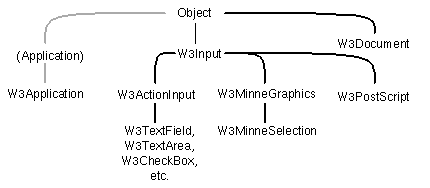
Figure 1. The W3Kit class hierarchy.
The largest part of W3Kit is an object-oriented class library used for developing CGI-compliant server scripts. The library is designed to support a familiar programming model and hide the stateless, distributed nature of CGI-based applications.
Figure 1. The W3Kit class hierarchy.
The classes provided by W3Kit fall into three general categories:
These are 2D and 3D abstract drawing area widgets, with 2D graphics based on either PostScript or raw X11, and 3D graphics on MinneGraphics (the Geometry Center's common interface to Renderman, GL, and X11). The widgets also provide a high-level interface for handling mouse events.
These classes are wrappers for the usual Fill-Out Form input widgets. The purpose of wrapping HTML widgets in objects is to maintain the logical connections between them. Each such interface object knows about a target object which it will notify of user input, and an action message which it will send to the target to accomplish this notification.
The W3Application class manages communication with the HTTP server as well as any display servers needed for drawing. The W3Document class manages the translation between files, streams, and URLs.
For more detailed information on particular classes, see the class reference.
![[HOME]](/pix/home.gif) The Geometry Center Home Page
The Geometry Center Home Page
Author: Paul Burchard
Comments to:
webmaster@geom.umn.edu
Created: Apr 18 1994 ---
Last modified: Jun 18 1996